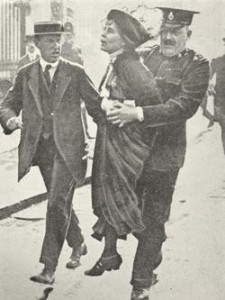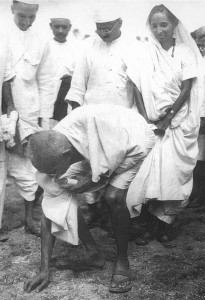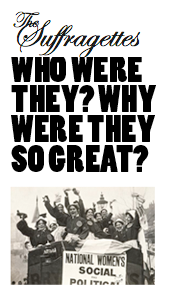Direct Action
Follow @ClimateRush
Direct action has a long and proud history of being a force for radical change. From the anti-slavery movement to human rights and environmental activists today, every freedom we have has been fought for and protected by people willing to speak up for their rights and the rights of others.
Direct action involves pushing the boundaries of what is acceptable in society and in law - not always breaking the law, but challenging it, showing that another world is possible and calling for change. It can take many forms, from sitting on a bus to shutting down a power station, but what they all have in common is a refusal to accept the status quo and a determination to claim the rights - to non-segregated buses, or clean air - that are currently being denied. Here are some of our favourite examples from history…

This is Emmeline Pankhurst, getting arrested on May 21st, 1914, outside Buckingham Palace. She was with a group of two hundred women taking a petition to the King. They were met by no fewer than fifteen hundred police.
The Suffragettes had a whole range of tactics, from disrupting meetings to putting jam through the letter boxes of prominent politicians. They got properly militant after the 1910 election, when it became clear that the police would rather hit and molest them than arrest them – that’s why they started breaking windows, because then they’d have to be sent straight to prison.
There were some things they did that some people think went too far, like burning down the greenhouses in Kew gardens, but they never endangered a human life. Lots of people didn’t like them, and some thought they harmed the cause of women’s rights – but they kept it in the papers when it had stopped being a talking point, and they could regularly get a hundred thousand people at their rallies.

This is Ghandi, picking up salty mud in Dandi, Gujarat on April 5th, 1930. He’d just walked 240 miles to the coast of India, picking up a huge procession – by the time they arrived it was 2 miles long. The colonial government had made it illegal for Indians to make their own salt, giving British companies a monopoly and impoverishing ordinary people. Ghandi broke the law openly, making salt in front of the authorities and accepting the punishment of imprisonment. Hundreds of thousands followed him, and by the end of the month sixty thousand people had been arrested. It didn’t change the law, and it was another seventeen years before colonialism ended, but its effect was still profound. As Nehru said:
“the real importance, to my mind, lay in the effect they had on our own people, and especially the village masses….Non-cooperation dragged them out of the mire and gave them self-respect and self-reliance….They acted courageously and did not submit so easily to unjust oppression; their outlook widened and they began to think a little in terms of India as a whole….It was a remarkable transformation.”

This is Rosa Parks, on December 1st 1955. She refused to move to the ‘black’ section of the bus, which sparked off a 381 day boycott of the bus services in Montgomery Alabama. Forty-thousand African-American commuters refused to use the bus for over a year, forcing the segregation laws on transport to be changed. A radical and organised force fighting for equal rights was formed, eventually leading to the end of segregation altogether in the Civil Rights Act, 1964.

Vivoleum is a fake form of fuel, apparently made from the human bodies of the victims of climate change. The Yes Men used it as a stunt in June 2007, posing as reps of Exxon Mobile and National Petroleum Council at Canada’s largest oil conference. “We need something like whales, but infinitely more abundant,” said “NPC rep” “Shepard Wolff” (actually Andy Bichlbaum), before describing the technology used to make human flesh into a new Exxon oil product called Vivoleum.

This is Kingsnorth power station in Kent, one of the biggest emitters in the country, and the site of Climate Camp 2008. Protesters at the time failed to get shut the building down, but on November 28th last year a mysterious intruder breached security, made it all the way inside the plant and switched the turbines off. He or she was so modest about it they didn’t press release it, and to this day no-one knows their name. Eventually E.ON had to admit they’d had a security breach and that the power station had been off for a while that day. We do need a mass movement, and huge numbers taking part in civil disobedience, but small actions by really brave individuals can also be really effective.






